- Преподавателю
- Иностранные языки
- The History of Film
The History of Film
| Раздел | Иностранные языки |
| Класс | 11 класс |
| Тип | Презентации |
| Автор | Шебелян С.О. |
| Дата | 15.05.2015 |
| Формат | zip |
| Изображения | Есть |
Муниципальное Общеобразовательное Учреждение
Лицей №2
«The history of cinematography».
Учитель:
Шебелян Стелла Овакимовна
Саратов 2014
Contents:
I Inroduction:
II «The history of Cinematography»./
1) The Pre-1920s , Early Cinematic Origins and the Infancy of Film:
2) The 1920s . The Pre-Talkies and the Silent Era:
3) The 1930s . The Talkies, the Growth of the Studios, and 'The Golden Age of Hollywood':
4) The 1940s. The War and Post-War Years. The Beginnings of Film Noir:
5) The 1950s . The Cold War and Post-Classical Era ,The Era of Epic Films and the Threat of Television:
6) The 1960s, The End of the Hollywood Studio System, The Era of Independent, Underground Cinema:
7) The 1970s, The Last Golden Age of American Cinema (the American "New Wave") and the Advent of the Blockbuster Film9):
8) The 1980s, Teen-Oriented Angst Films and the Dawn of the Sequel, with More Blockbusters:
9) The 1990s , The Era of Mainstream Films and "Indie" Cinema, the Rise of Computer-Generated Imagery, the Decade of Re-makes, Re-releases, and More Sequels:
10) The 2000s, The New Millennium, an Age of Advanced Special Effects (CGI and Performance Capture) and the Era of Franchise Films:
III Conclusion
IV Literature,
Introduction.
Our work is devoted to the « History of Cinematography». We suppose that this topic is very interesting/and actual nowadays. We hope that our research will be interesting and useful. The aim of our work is to find out interesting and unknown facts about the cinema. The cinema has arisen not so long ago, about 100 years ago! But for this short time has already reached many results. In this work we would like to tell you about the history of cinema's development. As it was shot the first black-and-white films, sound cinema, color films. Occurrence of the first film studios, their development and the contribution to cinema history! We shall tell you about the well-known actors of that time. And certainly about Hollywood.
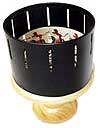 The History of Film
The History of Film
The Pre-1920s
Early Cinematic Origins and
the Infancy of Film
Innovations Necessary for the Advent of Cinema:
Optical toys, shadow shows, 'magic lanterns,' and visual tricks have existed for thousands of years. Many inventors, scientists, manufacturers and scientists have observed the visual phenomenon that a series of individual still pictures set into motion created the illusion of movement - a concept termed persistence of vision. This illusion of motion was first described by British physician Peter Mark Roget in 1824, and was a first step in the development of the cinema.
A number of technologies, simple optical toys and mechanical inventions related to motion and vision were developed in the early to late 19th century that were precursors to the birth of the motion picture industry:
-
A very early version of a "magic lantern" was invented in the 17th century by Athanasius Kircher in Rome. It was a device with a lens that projected images from transparencies onto a screen, with a simple light source (such as a candle).
-
1824 - the invention of the Thaumatrope (the earliest version of an optical illusion toy that exploited the concept of "persistence of vision" first presented by Peter Mark Roget in a scholarly article) by an English doctor named Dr. John Ayrton Paris
-
1831 - the discovery of the law of electromagnetic induction by English scientist Michael Faraday, a principle used in generating electricity and powering motors and other machines (including film equipment)
-
1832 - the invention of the Fantascope (also called Phenakistiscope or "spindle viewer") by Belgian inventor Joseph Plateau, a device that simulated motion. A series or sequence of separate pictures depicting stages of an activity, such as juggling or dancing, were arranged around the perimeter or edges of a slotted disk. When the disk was placed before a mirror and spun or rotated, a spectator looking through the slots 'perceived' a moving picture.
-
1834 - the invention and patenting of another stroboscopic device adaptation, the Daedalum (renamed the Zoetrope in 1867 by American William Lincoln) by British inventor William George Horner. It was a hollow, rotating drum/cylinder with a crank, with a strip of sequential photographs, drawings, paintings or illustrations on the interior surface and regularly spaced narrow slits through which a spectator observed the 'moving' drawings.
-
1839 - the birth of still photography with the development of the first commercially-viable daguerreotype (a method of capturing still images on silvered, copper-metal plates) by French painter and inventor Louis-Jacques-Mande Daguerre
-
1841 - the patenting of calotype (or Talbotype, a process for printing negative photographs on high-quality paper) by British inventor William Henry Fox Talbot
-
1861 - the invention of the Kinematoscope, patented by Philadelphian Coleman Sellers, an improved rotating paddle machine to view (by hand-cranking) a series of stereoscopic still pictures on glass plates that were sequentially mounted in a cabinet-box
-
1869 - the development of celluloid by John Wesley Hyatt, patented in 1870 and trademarked in 1873 - later used as the base for photographic film
-
1870 - the first demonstration of the Phasmotrope (or Phasmatrope) by Henry Renno Heyl in Philadelphia, that showed a rapid succession of still or posed photographs of dancers, giving the illusion of motion
-
1877 - the invention of the Praxinoscope by French inventor Charles Emile Reynaud - it was a 'projector' device with a mirrored drum that created the illusion of movement with picture strips, a refined version of the Zoetrope with mirrors at the center of the drum instead of slots; public demonstrations of the Praxinoscope were made by the early 1890s with screenings of 15 minute 'movies' at his Parisian Theatre Optique
-
1879 - Thomas Alva Edison's first public exhibition of an efficient incandescent light bulb, later used for film projectors
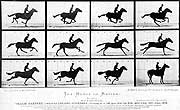
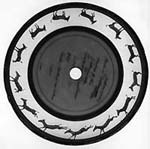

Late 19th Century Inventions and Experiments: Muybridge, Marey, Le P rince and Eastman
rince and Eastman
Pioneering Britisher Eadweard Muybridge (1830-1904), an early photographer and inventor, was famous for his photographic loco-motion studies (of animals and humans) at the end of the 19th century (such as 1882's published "The Horse in Motion"). In the 1870s, Muybridge experimented with instantaneously recording the movements of a galloping horse, first at a Sacramento (California) race track. In June, 1878, he successfully conducted a 'chronophotography' experiment in Palo Alto (California) for his wealthy San Francisco benefactor, Leland Stanford, using a multiple series of cameras to record a horse's gallops - this conclusively proved that all four of the horse's feet were off the ground at the same time.
Muybridge's pictures, published widely in the late 1800s, were often cut into strips and used in a Praxinoscope, a descendant of the zoetrope device, invented by Charles Emile Reynaud in 1877. The Praxinoscope was the first 'movie machine' that could project a series of images onto a screen. Muybridge's stop-action series of photographs helped lead to his own 1879 invention of the Zoopraxiscope (or "zoogyroscope", also called the "wheel of life"), a primitive motion-picture projector machine that also recreated the illusion of movement (or animation) by projecting images - rapidly displayed in succession - onto a screen from photos printed on a rotating glass disc.
True motion pictures, rather than eye-fooling 'animations', could only occur after the development of film (flexible and transparent celluloid) that could record split-second pictures. Some of the first experiments in this regard were conducted by Parisian innovator and physiologist Etienne-Jules Marey in the 1880s. He was also studying, experimenting, and recording bodies (most often of flying animals, such as pelicans in flight) in motion using photographic means (and French astronomer Pierre-Jules-Cesar Janssen's "revolving photographic plate" idea).
In 1882, Marey, often claimed to be the 'inventor of cinema,' constructed a camera (or "photographic gun") that could take multiple (12) photographs per second of moving animals or humans - called chronophotography or serial photography, similar to Muybridge's work on taking multiple exposed images of running horses. [The term shooting a film was possibly derived from Marey's invention.] He was able to record multiple images of a subject's movement on the same camera plate, rather than the individual images Muybridge had produced.
Marey's chronophotographs (multiple exposures on single glass plates and on strips of sensitized paper - celluloid film - that passed automatically through a camera of his own design) were revolutionary. He was soon able to achieve a frame rate of 30 images. Further experimentation was conducted by French-born Louis Aime Augustin Le Prince in 1888. Le Prince used long rolls of paper covered with photographic emulsion for a camera that he devised and patented. Two short fragments survive of his early motion picture film (one of which was titled Traffic Crossing Leeds Bridge).
The work of Muybridge, Marey and Le Prince laid the groundwork for the development of motion picture cameras, projectors and transparent celluloid film - hence the development of cinema. American inventor George Eastman, who had first manufactured photographic dry plates in 1878, provided a more stable type of celluloid film with his concurrent developments in 1888 of sensitized paper roll photographic film (instead of glass plates) and a convenient "Kodak" small box camera (a still camera) that used the roll film. He improved upon the paper roll film with another invention in 1889 - perforated celluloid (synthetic plastic material coated with gelatin) roll-film with photographic emulsion.
The Birth of US Cinema: Thomas Edison and William K.L. Dickson
In the late 1880s, famed American inventor Thomas Alva Edison (1847-1931) (and his young British assistant William Kennedy Laurie Dickson (1860-1935)) in his laboratories in West Orange, New Jersey, borrowed from the earlier work of Muybridge, Marey, Le Prince and Eastman. Their goal was to construct a device for recording movement on film, and another device for viewing the film. Dickson must be credited with most of the creative and innovative developments - Edison only provided the research program and his laboratories for the revolutionary work.
Although Edison is often credited with the development of early motion picture cameras and projectors, it was Dickson, in November 1890, who devised a crude, motor-powered camera that could photograph motion pictures - called a Kinetograph. This was one of the major reasons for the emergence of motion pictures in the 1890s. Edison Studios was formally known as the Edison Manufacturing Company (1894-1911), with innovations due largely to the work of Edison's assistant Dickson in the mid-1890s.
The motor-driven camera was designed to capture movement with a synchronized shutter and sprocket system (Dickson's unique invention) that could move the film through the camera by an electric motor. The Kinetograph used film which was 35mm wide and had sprocket holes to advance the film. The sprocket system would momentarily pause the film roll before the camera's shutter to create a photographic frame (a still or photographic image). The formal introduction of the Kinetograph in October of 1892 set the standard for theatrical motion picture cameras still used today. However, moveable hand-cranked cameras soon became more popular, because the motor-driven cameras were heavy and bulky.
In 1891, Dickson also designed an early version of a movie-picture projector (an optical lantern viewing machine) based on the Zoetrope - called the Kinetoscope. In 1889 or 1890, Dickson filmed his first experimental Kinetoscope trial film, Monkeyshines No. 1, the only surviving film from the cylinder kinetoscope, and apparently the first motion picture ever produced on photographic film in the United States. It featured the movement of laboratory assistant Sacco Albanese, filmed with a system using tiny images that rotated around the cylinder.
The first public demonstration of motion pictures in the US using the Kinetoscope occurred at the Edison Laboratories to the Federation of Women's Clubs on May 20, 1891, with the showing of Dickson Greeting. The very short film's subject in the test footage was William K.L. Dickson himself, bowing, smiling and ceremoniously taking off his hat.
On Saturday, April 14, 1894, a refined version of Edison's Kinetoscope began commercial operation. The floor-standing, box-like viewing device was basically a bulky, coin-operated, movie "peep show" cabinet for a single customer (in which the images on a continuous film loop-belt were viewed in motion as they were rotated in front of a shutter and an electric lamp-light). The Kinetoscope, the forerunner of the motion picture film projector (without sound), was finally patented on August 31, 1897 (Edison applied for the patent in 1891). The viewing device quickly became popular in carnivals, Kinetoscope parlors, amusement a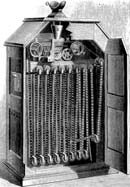 rcades, and sideshows for a number of years.
rcades, and sideshows for a number of years.
The world's first film production studio - or "America's first movie studio," the Black Maria, or the Kinetographic Theater (and dubbed "The Doghouse" by Edison himself), was built on the grounds of Edison's laboratories at West Orange, New Jersey, on February 1, 1893, at a cost of $637.67. It was constructed for the purpose of making film strips for the Kinetoscope. It was a black, tar-paper covered building/studio (with a retractable or hinged, flip-up roof to allow sunlight in), and built with a turntable to orient itself throughout the day to follow the natural sunlight.
In early May of 1893 at the Brooklyn Institute of Arts and Sciences, Edison conducted the world's first public demonstration of films viewed through a Kinetoscope viewer and shot using the Kinetograph in the Black Maria. The exhibited 34-second film was titled Blacksmith Scene, and showed three people pretending to be blacksmiths.
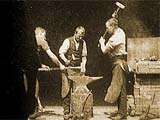
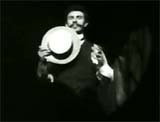
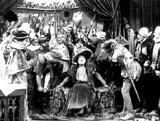
1920
The First Feature-Length Films:
I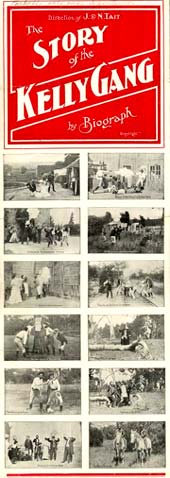 n the early years of cinema, film producers were worried that the American public could not last through a film that was an hour long, thereby delaying the advent of feature films (60-90 minutes in length) in the US. According to most sources, the first continuous, full-length narrative feature film (defined as a commercially-made film at least an hour in length) was writer/director Charles Tait's five-reel biopic of a notorious outback folk hero and bushranger, The Story of the Kelly Gang (1906, Australia), with a running time of between 60-70 minutes. Only fragments of the film survive to this day. Australia was the only country set up to regularly produce feature-length films prior to 1911.
n the early years of cinema, film producers were worried that the American public could not last through a film that was an hour long, thereby delaying the advent of feature films (60-90 minutes in length) in the US. According to most sources, the first continuous, full-length narrative feature film (defined as a commercially-made film at least an hour in length) was writer/director Charles Tait's five-reel biopic of a notorious outback folk hero and bushranger, The Story of the Kelly Gang (1906, Australia), with a running time of between 60-70 minutes. Only fragments of the film survive to this day. Australia was the only country set up to regularly produce feature-length films prior to 1911.
[The film was remade many times, notably as director Tony Richardson's Ned Kelly (1970) with rock star Mick Jagger in the lead role, and as Ned Kelly (2003) with Heath Ledger, Orlando Bloom, Geoffrey Rush and Naomi Watts.]
The first US documentary re-creation, Sigmund Lubin's one-reel film The Unwritten Law (1907) (subtitled "A Thrilling Drama Based on the Thaw-White Case/Tragedy") dramatized the true-life murder -- on June 25, 1906 -- of prominent architect Stanford White by mentally unstable and jealous millionaire Harry Kendall Thaw over the affections of model/showgirl Evelyn Nesbit (who appeared as herself), Thaw's wife. The film was considered quite controversial for its sensational and scandalous story of murder and sex. [Alluring chorine Nesbit would become a brief sensation, and the basis for Richard Fleischer's biopic film The Girl in the Red Velvet Swing (1955), portrayed by Joan Collins, and E.L. Doctorow's musical and film Ragtime (1981), portrayed by an Oscar-nominated Elizabeth McGovern.]
The first feature-length film made in Europe was from France - Michel Carre's L'Enfant Prodigue (1907, Fr.), an adaptation of a stage play, that premiered in Paris on June 20, 1907. The first feature-length film produced in the US was Vitagraph's Les Miserables (1909) (each reel of the four-reel production was released separately). A second feature film, Stuart Blackton's Vitagraph five-reel production titled The Life of Moses (1909) was also released in separate installments.
The first feature-length film to be released in its entirety in the US was the 69-minute epic Dante's Inferno (1911, It.) (aka L'Inferno), inspired by Dante's 14th century poem The Divine Comedy. It opened in New York on December 10, 1911 at Gane's Manhattan Theatre. It was made by three directors Francesco Bertolini, Giuseppe de Liguoro, and Adolfo Padovan, took two years to make, and cost over $180,000.
The first US feature film to be shown in its entirety was H. A. Spanuth's five-reel production of Oliver Twist (1912). The four-reel silent costume drama Queen Elizabeth (1912, Fr.) (aka Les Amours de la Reine Élisabeth) (starring Sarah Bernhardt) was the third film to be shown whole, in its US premiere in July at the Lyceum Theatre in NYC. The five-reel Richard III (1912) is thought to be the earliest surviving complete feature film made in the US. Although US production and exhibition of feature films started slowly in 1912, the next few years demonstrated tremendous growth when foreign competition (with often superior products) encouraged development.
Stars and Studios of the Era:
Major stars in the decade before and into the Roaring Twenties included Ramon Novarro, Rudolph Valentino, Francis X. Bushman, Broncho Billy Anderson, Mary Pickford, Clara Bow, John Gilbert, Charlie Chaplin, Colleen Moore, Alla Nazimova, Lillian Gish, King Baggot, Theda Bara, Douglas Fairbanks, Sr., Pearl White, German shepherd Rin Tin Tin, Louise Brooks, Bessie Love, Pola Negri, Tom Mix, Gloria Swanson, Norma Talmadge, Brigitte Helm, Emil Jannings, Marion Davies, and William S. Hart.
1930 The Major Film Studios: The Big Five
1920-1930 was the decade between the end of the Great War and the Depression following the Stock Market Crash. Film theaters and studios were not initially affected in this decade by the Crash in late 1929. The basic patterns and foundations of the film industry (and its economic organization) were established in the 1920s. The studio system was essentially born with long-term contracts for stars, lavish production values, and increasingly rigid control of directors and stars by the studio's production chief and in-house publicity departments. After World War I and into the early 1920s, America was the leading producer of films in the world - using Thomas Ince's "factory system" of production, although the system did limit the creativity of many directors. Production was in the hands of the major studios (that really flourished after 1927 for almost 20 years), and the star system was burgeoning.
Originally, in the earliest years of the motion picture industry, production, distribution, and exhibition were separately controlled. When the industry rapidly grew, these functions became integrated under one directorship to maximize profits, something called vertical integration. There were eight major (and minor) studios (see below) that dominated the industry. They were the ones that had most successfully consolidated and integrated all aspects of a film's development. By 1929, the film-making firms that were to rule and monopolize Hollywood for the next half-century were the giants or the majors, sometimes dubbed The Big Five. They produced more than 90 percent of the fiction films in America and distributed their films both nationally and internationally. Each studio somewhat differentiated its products from other studios.
The Big Five Studios
Logo
1.
Warner Bros. Pictures, incorporated in 1923 by Polish brothers (Jack, Harry, Albert, and Sam); in 1925, Warner Brothers merged with First National, forming Warner Bros.-First National Pictures; the studio's first principal asset was Rin Tin Tin; became prominent by 1927 due to its introduction of talkies (The Jazz Singer (1927)) and early 30s gangster films; it was known as the "Depression studio"; in the 40s, it specialized in Bugs Bunny animations and other cartoons
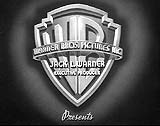
Warner Bros.
2.
Adolph Zukor's Famous Players (1912) and Jesse Lasky's Feature Play - merged in 1916 to form Famous Players-Lasky Corporation; it spent $1 million on United Studios' property (on Marathon Street) in 1926; the Famous Players-Lasky Corporation became Paramount studios in 1927, and was officially named Paramount Pictures in 1935; its greatest silent era stars were Mary Pickford and Douglas Fairbanks, and Rudolph Valentino; Golden Age stars included Mae West, W.C. Fields, Bing Crosby, Bob Hope, and director Cecil B. DeMille

Famous Players-Lasky
(Paramount)
3.
RKO (Radio-Keith-Orpheum) Pictures, evolved from the Mutual Film Corporation (1912), was established in 1928 as a subsidiary of RCA; it was formed by RCA, Keith-Orpheum Theaters, and the FBO Company (Film Booker's Organization) - which was owned by Joseph P. Kennedy (who had already purchased what remained of Mutual); this was the smallest studio of the majors; kept financially afloat with top-grossing Astaire-Rogers musicals in the 30s, King Kong (1933), and Citizen Kane (1941); at one time, RKO was acquired by eccentric millionaire Howard Hughes

RKO
4.
Fox Film Corporation/Foundation, founded in 1912 by NY nickelodeon owner William Fox (originally a garment industry worker), was first known for Fox Movietone news and then B-westerns; its first film was Life's Shop Window (1914); it later became 20th-Century Fox, formed through the 1935 merger of 20th Century Pictures Company (founded in 1933 by Darryl F. Zanuck) and Fox; it became famous for Shirley Temple films in the mid-30s and Betty Grable musicals in the 40s

Movietone Newsreels

5.
Marcus Loew of Loew's, Inc., was the parent firm of what eventually became Metro-Goldwyn-Mayer. Metro Pictures Corporation was a production company founded in 1916 by Richard A. Rowland and Louis B. Mayer. In 1918, Mayer left this partnership to start up his own production company in 1918, called Louis B. Mayer Pictures. In 1920, Metro Pictures Corporation (with its already-acquired Goldwyn Pictures Corporation) was purchased by early theater exhibitor Marcus Loew of Loew's Inc. In another acquisition, Loew merged his 'Metro-Goldwyn production company with Louis B. Mayer Pictures.
So, in summary, MGM, first named Metro-Goldwyn Pictures, was ultimately formed in 1924 from the merger of three US film production companies: Metro Pictures Corporation (1916), Goldwyn Pictures Corporation (1917), and the Louis B. Mayer Pictures Company (1918); Irving Thalberg (nicknamed the 'boy wonder') was head of production at MGM from 1924 until his death in 1936; the famous MGM lion roar in the studio's opening logo was first recorded and viewed in a film in 1928; its greatest early successes were The Big Parade (1925), Broadway Melody (1929), Grand Hotel (1932), Mutiny on the Bounty (1935), A Night at the Opera (1935), The Good Earth (1937), Gone With the Wind (1939), The Wizard of Oz (1939), as well as Tarzan films, Tom and Jerry cartoons, and stars such as Clark Gable, Greta Garbo, and Spencer Tracy
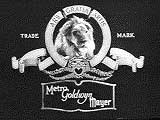
Metro-Goldwyn-Mayer
The Big-Five studios had vast studios with elaborate sets for film production. They owned their own film-exhibiting theatres (about 50% of the seating capacity in the US in mostly first-run houses in major cities), as well as production and distribution facilities. They distributed their films to this network of studio-owned, first-run theaters (or movie palaces), mostly in urban areas, which charged high ticket prices and drew huge audiences. They required blind or block bookings of films, whereby theatre owners were required to rent a block of films (often cheaply-made, less-desirable B-pictures) in order for the studio to agree to distribute the one prestige A-level picture that the theatre owner wanted to exhibit. This technique set the terms for a film's release and patterns of exhibition and guaranteed success for the studio's productions. [Monopolistic studio control lasted twenty years until the late 1940s, when a federal decree (in U.S. vs. Paramount) ordered the studios to divest their theatres, similar to the rulings against the MPPC - the Edison Trust.]
The Beginning of the Academy Awards:
The non-profit organization, the Academy of Motion Picture Arts and Sciences (AMPAS) was founded in 1927 with Douglas Fairbanks as president, to recognize and reward excellence within the film industry. The AMPAS organization established the Academy Awards in the late 1920s and first announced them in February 1929, and then distributed them in mid-May of 1929 for films opening between August-1927 and late July-1928.
In the first year of the Academy Awards' presentations, separate awards (not known as Oscar quite yet) were given for Best Production (now termed Best Picture). There were two "Best Picture" winners: the financially successful anti-war film, William A. Wellman's Wings (1927) for Best Production and Sunrise (1927) for Best Unique and Artistic Picture (a category that was immediately dropped). Wings (1927), coming at the end of a cycle of films about WWI, featured exciting aerial combat sequences and starred Clara Bow and a young actor named Gary Cooper. These films were the only silent films ever to win the Academy Award for 'Best Picture'. The Jazz Singer (1927), declared ineligible for the Best Picture award, was given a special award for revolutionizing the industry.
1930
The Golden Age of Hollywood: From 1930 to 1948
The 1930s decade (and most of the 1940s as well) has been nostalgically labeled "The Golden Age of Hollywood" (although most of the output of the d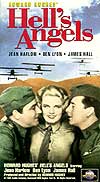 ecade was black-and-white). The 30s was also the decade of the sound and color revolutions and the advance of the 'talkies', and the further development of film genres (gangster films, musicals, newspaper-reporting films, historical biopics, social-realism films, lighthearted screwball comedies, westerns and horror to name a few). It was the era in which the silent period ended, with many silent film stars not making the transition to sound (e.g., Vilmy Banky, John Gilbert, and Norma Talmadge). By 1933, the economic effects of the Depression were being strongly felt, especially in decreased movie theatre attendance.
ecade was black-and-white). The 30s was also the decade of the sound and color revolutions and the advance of the 'talkies', and the further development of film genres (gangster films, musicals, newspaper-reporting films, historical biopics, social-realism films, lighthearted screwball comedies, westerns and horror to name a few). It was the era in which the silent period ended, with many silent film stars not making the transition to sound (e.g., Vilmy Banky, John Gilbert, and Norma Talmadge). By 1933, the economic effects of the Depression were being strongly felt, especially in decreased movie theatre attendance.
As the 1930s began, there were a number of unique firsts:
-
young 'platinum blonde' star Jean Harlow appeared in her first major role in Howard Hughes' World War I aviation epic, Hell's Angels (1930); the "Blonde Bombshell" was signed by MGM in 1932 and soon became a major star
-
e
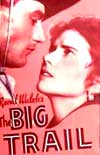 nigmatic silent star Greta Garbo (originally named Greta Lovisa Gustafsson), part of MGM's galaxy of stars and nicknamed "The Divine Garbo" and "The Swedish sphinx," spoke her first immortal, husky, Swedish-accented words in director Clarence Brown's MGM film Anna Christie (1930). (As a floozy, she spoke: "Gimme a vhiskey, ginger ale on the side. And don't be stingy, baby") - it was Garbo's first talkie (advertised as "GARBO TALKS!")
nigmatic silent star Greta Garbo (originally named Greta Lovisa Gustafsson), part of MGM's galaxy of stars and nicknamed "The Divine Garbo" and "The Swedish sphinx," spoke her first immortal, husky, Swedish-accented words in director Clarence Brown's MGM film Anna Christie (1930). (As a floozy, she spoke: "Gimme a vhiskey, ginger ale on the side. And don't be stingy, baby") - it was Garbo's first talkie (advertised as "GARBO TALKS!") -
the first of Hollywood's dramatic prison dramas (a new subgenre) was p
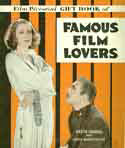 roduced by MGM, The Big House (1930), directed by George Hill
roduced by MGM, The Big House (1930), directed by George Hill -
B-actor John Wayne made his debut in his first major role in a western directed by Raoul Walsh, The Big Trail (1930) - one of the first films shot in Grandeur, Fox's experimental wide-screen 70mm format. Both the film and the new process flopped; it would be nine more years before his star-making appearance in Stagecoach (1939)
-
Broadway actress Helen Hayes made her screen debut in The Sin of Madelon Claudet (1931) and won the Best Actress Academy Award for her first talkie
-
MGM stars Clark Gable and Joan Crawford starred together in the risque pre-Code film Dance, Fools, Dance (1931), the first of eight features that teamed them together
-
the best-known Charlie Chan actor, Warner Oland, played the detective for the first time in Charlie Chan Carries On (1931)
-
RKO won its sole Best Picture Academy Award for the western Cimarron (1931)
-
in 1930, the Motion Picture Production Code, administered by Joseph I. Breen (and former Postmaster General Will Hays) set film guidelines regarding sex, violence, religion, and crime (not yet strictly enforced until the Production Code Administration (1934))
-
the first daily newspaper for the film industry had its debut in 1930, The Hollywood Reporter
-
Katharine Hepburn made her screen debut in A Bill of Divorcement (1932)
-
Olympic swimming champion Johnny Weissmuller made his screen debut as the vine-swinging ape-man in Tarzan, the Ape Man (1932)
-
Curly-topped, dimpled child star Shirley Temple appeared in her first films, an Our Gang type series of shorts titled Baby Burlesks (1933)
-
the first appearance of the cartoon character Popeye was in the Betty Boop cartoon from Paramount and Max Fleischer, Popeye the Sailor (1933)
-
the world's first drive-in theatre opened in Camden, N.J. in June, 1933; the fourth drive-in was located on Pico in Los Angeles, CA and opened in September, 1934
-
the first Three Stooges comedy film (the first of their 190 slapstick comedy films that lasted through 1959) with Moe Howard, Larry Fine, and Curly Howard, was released by Columbia, the short Woman Haters (1934) (with all the dialogue in rhyme)
-
Walt Disney's 8-minute The Wise Little Hen (1934) featured the first appearance of Donald Duck
-
the longest Hollywood talkie released up to that time, MGM's The Great Ziegfeld (1936), at 2 hours, 59 minutes
-
MGM star Spencer Tracy won consecutive Best Actor Oscars in the late 30s for his appearances in Captains Courageous (1937) and Boys Town (1938) - this wouldn't happen again until Tom Hanks won back-to-back Oscars in the 90s for Philadelphia (1993) and Forrest Gump (1994)
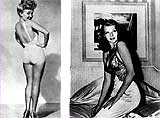 1940 Hollywood During the War Years
1940 Hollywood During the War Years
The early years of the 40s decade were not promising for the American film industry, especially following the late 1941 attack on Pearl Harbor by the Japanese, and the resultant loss of foreign markets. However, Hollywood film production rebounded and reached its profitable peak of efficiency during the years 1943 to 1946 - a full decade and more after the rise of sound film production, now that the technical challenges of the early 30s sound era were far behind. Advances in film technology (sound recording, lighting, special effects, cinematography and use of color) meant that films were more watchable and 'modern'. Following the end of the war, Hollywood's most profitable year in the decade was 1946, with all-time highs recorded for theatre attendance.
The world was headed toward rearmament and warfare in the early to mid-1940s, and the movie industry, like every other aspect of life, responded to the national war effort by making movies, producing many war-time favorites, and having stars (and film industry employees) enlist or report for duty. The US government's Office of War Information (OWI), formed in 1942, served as an important propaganda agency during World War II, and coordinated its efforts with the film industry to record and photograph the nation's war-time activities. Tinseltown aided in the defensive mobilization, whether as combatants, propagandists, documentary, newsreel or short film-makers, educators, fund-raisers for relief funds or war bonds, entertainers, or morale-boosters. Films took on a more realistic rather than escapist tone, as they had done during the Depression years of the 30s.
Hollywood Canteen (1944), the West Coast's answer to Broadway's Stage Door Canteen (1943), was typical of star-studded, plotless, patriotic extravaganzas, one of several during the war years which featured big stars who entertained the troops. [Originally, the Hollywood Canteen was a nightclub for off-duty servicemen, founded in 1942 by movie stars Bette Davis, John Garfield, and others. It provided free meals and entertainment, and was located at 1451 Cahuenga Boulevard, off Sunset Boulevard.] Big name stars and directors either enlisted, performed before soldiers at military bases, or in other ways contributed to the war mobilization. Many of the leading stars and directors in motion pictures joined the service or were called to duty - Clark Gable, James Stewart, William Wyler, and Frank Capra to name a few, and male actors were definitely in short supply. Rationing, blackouts, shortages and other wartime restrictions also had their effects on US film-makers, who were forced to cut back on set construction and on-location shoots.
The End of the Decade, and the Beginning of the End of the Studio System:
At the end of this decade, reeling from depression, war, problems of the return to peacetime, and the ominous arrival of the atomic bomb, the world was a more cynical, chaotic, economically-unsure and film-noirish place. Studios were also forced to re-evaluate their roles and approaches, with lawsuits that stripped the studios of their lucrative practices. By the late 1940s, the motion picture industry surely faced its period of greatest crisis and challenge, with the depressing bleakness of the Cold War on the horizon.
Hollywood suddenly found itself with many threatening forces at the close of the 40s and the start of the next decade:
-
the coming of television forcing potential moviegoers to remain at home
-
blacklisting and McCarthyism
-
a 1945 studio labor union strike that raised salaries 25% for studio employees
-
a short-lived 75% import duty, from 1947-1948, that restricted the import of all US films into the UK
-
the gradual decline of theatre-attending audiences
-
inflation that raised film production costs
-
anti-trust rulings by the US government against the studios
Block-booking of films was declared illegal and studios were forced to divest themselves of their studio-owned theatre chains by the Paramount Decrees (an action of the US Justice Department and an anti-monopoly decision of the US Supreme Court in 1948 against the Big Five major film studios and three minor studios). The court's anti-trust decision in U.S. vs. Paramount mandated that the production and exhibition functions of the film industry had to be separated.
Now that the studios would have to achieve box-office success based not on their marketplace strength but on the quality of their films - now sold by a film-by-film and theater-by-theater basis - the stability of the studio system of marketing was severely threatened and began to crumble. Studios would be gradually reduced to production and distribution organizations, forced to give up or divest themselves of their vast theater holdings, and prohibited from 'block booking', fixing admission prices, and forcing their lesser products onto independent exhibitors. They were pressured to usher in an era of competition, free agent stars and auteur directors, and many of them were forced to begin selling film rights to pre-1948 films to television to bolster profits.
1950. Hollywood's War Against Television:
The width-to-height aspect ratio of most Hollywood films before the 50s was 4:3 (or 1.33:1), similar to the boxy-size of a television screen. [However, it should be noted that there were early experiments in wide-screen formats as early as the late 1920s, such as in French director Abel Gance's epic Napoleon (1927), with its Polyvision and 3-screen projection, or in Fox's 70mm. wide-gauge "Grandeur" system first used in Raoul Walsh's The Big Trail (1930). Both systems were aborted attempts, and turned out to be uneconomically viable at the time.]
So in its war against television, the film industry had three major campaigns involving technical advances with wide-screen e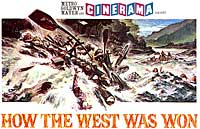 xperiences, color, and scope:
xperiences, color, and scope:
-
Cinerama
-
3-D and Smell-O-Vision
-
CinemaScope
-
Other Widescreen Formats and Processes
Cinerama (1952-1962)
![]()
Paramount's wrap-around, big-screen Cinerama debuted in 1952, a break-through technique that required three cameras, three projectors, interlocking, semi-curved (at 146 degrees) screens, and four-track stereo sound. It made audiences feel that they were at the center of the action.
The first film using the three-strip cinerama process was This is Cinerama (1952), a travelogue of the world's vacation spots, with a thrilling roller-coaster ride. Although there were a few successful box-office Cinerama hits in the 1950s, the process was ultimately abandoned because its novelty wore off and the equipment and construction of special theatres was too cost-prohibitive and cumbersome:
-
Cinerama Holiday (1955)
-
The Seven Wonders of the World (1957)
-
the Lowell Thomas production of Search for Paradise (1958)
-
The Wonderful World of the Brothers Grimm (1962)
-
the last Cinerama-released film, How the West Was Won (1962)
[In the 60s, MGM and UA also produced films including Khartoum (1966), It's a Mad, Mad, Mad, Mad World (1965), and The Greatest Story Ever Told (1965) in 70 mm. Ultra Panavision for Cinerama screens, dubbed Super Cinerama or Cinerama 70mm. In 1963, the world's largest Cinerama screen - Cinerama Dome - was 90 feet wide and unveiled in Hollywood.]
3-D Movies
In the same year as the debut of Cinerama (1952), showmanship and gimmicks l ike 3-D were used to bring audiences back. Special polarized, 'stereoscopic' goggles or cardboard glasses worn by viewers made the action jump off the screen - in reality, the glasses were unpopular, clunky and the viewing was blurry, although it was difficult (and expensive) for theatre owners to get cinema-goers to give them back. The 3-D effect was unable to compensate for the inferior level of most of the films.
ike 3-D were used to bring audiences back. Special polarized, 'stereoscopic' goggles or cardboard glasses worn by viewers made the action jump off the screen - in reality, the glasses were unpopular, clunky and the viewing was blurry, although it was difficult (and expensive) for theatre owners to get cinema-goers to give them back. The 3-D effect was unable to compensate for the inferior level of most of the films.
The first full-length 3-D feature sound film was UA's cheaply-made jungle adventure Bwana Devil (1952)) by writer/director Arch Oboler, and starring Robert Stack - its taglines advertised: "A Lion in Your Lap" and "A Lover In Your Arms." The film depicted man-eating lion attacks upon the builders of the Uganda Railway. [Note: The first feature-length 3-D film was The Power of Love (1922).]
The 3-D effect was also used in many different genres:
-
in horror films (Warners' and B-film maker Andre de Toth's House of Wax (1953) with horror master Vincent Price, a remake of Warners' The Mystery of the Wax Museum (1933)) - the first 3-D horror film to be in the top ten box office hits in its year of release, Vincent Price portrayed the owner of a macabre wax museum in his first horror film, House of Wax (1953)
-
in musicals (George Sidney's Kiss Me Kate (1953))
-
in romantic musical comedies (The French Line (1953) starring busty Jane Russell) - one provocative tagline touted: "It'll knock BOTH your eyes out"
-
in westerns (Douglas Sirk's Taza, Son of Cochise (1954))
-
in science fiction (the cheaply-made Robot Monster (1953), and It Came From Outer Space (1953) - the first 3-D science fiction film) - and shortly thereafter, in The Creature From the Black Lagoon (1954), a story of a Gill-Man set in the Amazon
-
in thrillers (Hitchcock's 3-D version of Dial M For Murder (1954))
1960 Daring Films in the 60s:
As film censorship was slowly being abolished in the US, a new freedom of language, subject matter and permissiveness was expressed in film, with more explicit treatments of sex and violence. In 1960, the Best Film Oscar went to Billy Wilder's The Apartment (1960) about an ambitious junior corporate w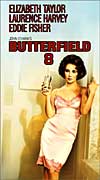 orker (Jack Lemmon) who loaned out his apartment as a love nest to the corporation's senior executives for sexual encounters. The corporate ladder-climbing employee was shocked when he learned that his elevator operator/girlfriend (Shirley MacLaine) was also one of the boss' victims. The film skewered the success-oriented decade of the 1950s and was regarded as somewhat risque at the time, but considered tame by the end of the 1960s. Jack Lemmon also starred as an alcoholic businessman with his boozing wife Lee Remick in Days of Wine and Roses (1962), noted for Henry Mancini's Oscar-winning title song.
orker (Jack Lemmon) who loaned out his apartment as a love nest to the corporation's senior executives for sexual encounters. The corporate ladder-climbing employee was shocked when he learned that his elevator operator/girlfriend (Shirley MacLaine) was also one of the boss' victims. The film skewered the success-oriented decade of the 1950s and was regarded as somewhat risque at the time, but considered tame by the end of the 1960s. Jack Lemmon also starred as an alcoholic businessman with his boozing wife Lee Remick in Days of Wine and Roses (1962), noted for Henry Mancini's Oscar-winning title song.
Another daring drama at the time was the glossy screen adaptation of John O'Hara's novel Butterfield 8 (1960) in which Elizabeth Taylor won her first Best Actress Award as an amoral, high-priced call girl in New York City. Italian director Federico Fellini's risque masterpiece La Dolce Vita (1960) (translated "The Sweet Life"), that marked the end of his Neo-Realistic period, starred Marcello Mastrioanni as a decadent society playboy and gossip columnist who pursued statuesque and busty film star Anita Ekberg to the Trevi Fountain.
British director Michael Powell's daring and controversial psychological thriller about voyeurism, Peeping Tom (1960), was criticized at the time of its release for being creepy, sick, perverse, and obscene, but since then has been re-evaluated and considered one of cinema's masterpieces. Director Elia Kazan's Splendor in the Grass (1961), a passionate love story between two high-school students in a small Kansas town, featured Hollywood's first on-screen, open-mouthed kiss and censored nudity of its young female star Natalie Wood in a bathtub as she screamed to her mother that she wasn't spoiled. It was also the first film for Warren Beatty and Sandy Dennis.
T o Kill a Mockingbird (1962) was a top-notch adaptation of Harper Lee's novel about a 1930s small-town, widowed southern lawyer (Oscar-winning Gregory Peck as Atticus Finch), with two children (Scout and Jem), who defended a falsely-accused black man against charges of the rape of a white woman - mixing two controversial topics (racism and rape). Two films in 1962 pushed for more explicit themes: Stanley Kubrick's Lolita (1962) dealt with the sensitive topic of pedophilia, and producer/director Otto Preminger's political-courtroom drama Advise and Consent (1962) involved homosexuality.
o Kill a Mockingbird (1962) was a top-notch adaptation of Harper Lee's novel about a 1930s small-town, widowed southern lawyer (Oscar-winning Gregory Peck as Atticus Finch), with two children (Scout and Jem), who defended a falsely-accused black man against charges of the rape of a white woman - mixing two controversial topics (racism and rape). Two films in 1962 pushed for more explicit themes: Stanley Kubrick's Lolita (1962) dealt with the sensitive topic of pedophilia, and producer/director Otto Preminger's political-courtroom drama Advise and Consent (1962) involved homosexuality.
Sidney Lumet's mainstream, socially-conscious melodrama about a Spanish Harlem Jewish shop owner - The Pawnbroker (1965) included a landmark scene of a woman undressing and baring her breasts - an integral component of the plot. The film was granted a Production Code seal, the first for a mainstream film containing nudity, beginning a trend toward nudity in other 60s American films. In 1967, a number of mainstream films helped spur the development of a ratings system, with their excessive amounts of explicit profanity and sexuality. Two films claimed to be the first film to use the four-letter F word: director Joseph Strick's Ulysses (1967) and Michael Winner's I'll Never Forget What's'isname (1967, UK) (i.e., "Get out of here, you f--king bastard!", spoken by actress Marianne Faithfull as Josie) The latter also included a scene that implied oral sex between Oliver Reed and Carol White, as did Charlie Bubbles (1967).
The disturbing crime drama The Boston Strangler (1968) told the grisly story of violent, self-confessed mass murderer Anthony DeSalvo (Tony Curtis). Ken Russell's version of D.H. Lawrence's Women in Love (1969) (with a Best Actress Oscar win for Glenda Jackson as Gudrun Brangwen), set in a mining community in Nottinghamshire, was infamous for its nude wrestling match between stars Oliver Reed and Alan Bates.
The New Ratings System:
By the late 1940s, the organization known as the MPPDA (Motion Picture Producers and Distributors of America) to administer the motion picture Production Code then became known as the Motion Picture Association of America (MPAA). In 1966, the Production Code Administration (and its Motion Picture Production Code) that had set moral standards in films for almost 30 years since its establishment in the early 1930s, was curtailed. Due to pressures emerging against the archaic censorship body, its new president Jack Valenti (appointed in 1966) abolished the Hays Code in 1967. It had become very obvious that the code was outdated and unnecessarily restrictive.
In November of 1968, a major revision in the ratings systems helped to encourage artistic freedom rather than censorship, and avoid the threat of government censorship. It let Hollywood film-makers compete against adult-oriented foreign film productions, and it lessened restraint toward questionable themes (sex and nudity, violence, obscenity, etc.) A new voluntary ratings code was announced to replace the decades-old Production Code, and it was to be administered by the Motion Picture Association of America (MPAA) (under the Classification and Rating Administration). Ratings were to be enforced by theaters, distributors and exhibitors. The four ratings were:
-
"G" (general audiences or suitable for all ages)
-
"M" (suggested for mature audiences - subsequently this was changed to GP and then PG for 'parental guidance' suggested)
-
"R" (restricted audiences - no one under age 16 admitted without an accompanying adult)
-
"X" (for those 16 years and older)
Soon afterwards in 1969, the M rating was changed to GP (General Patronage) and then to PG (meaning 'Parental Guidance Suggested') in 1970, and the a ge restriction was raised to 17 from 16. Rather than a form of pre-censorship or a restriction against pornography, the new system mainly offered advisory classification to exclude under-16s from X-rated films (later changed to 17), and categorized films according to their appropriateness for young viewers. Most filmmakers would subsequently try to avoid a G-rating (other than Disney's animations and true family fare) in order to raise their ratings to PG - and thereby increase their desirability by adult audiences. Many foreign film-makers chose to not submit their films to the ratings board, since their films didn't have widespread appeal anyway and would only play in arthouse venues.
ge restriction was raised to 17 from 16. Rather than a form of pre-censorship or a restriction against pornography, the new system mainly offered advisory classification to exclude under-16s from X-rated films (later changed to 17), and categorized films according to their appropriateness for young viewers. Most filmmakers would subsequently try to avoid a G-rating (other than Disney's animations and true family fare) in order to raise their ratings to PG - and thereby increase their desirability by adult audiences. Many foreign film-makers chose to not submit their films to the ratings board, since their films didn't have widespread appeal anyway and would only play in arthouse venues.
The First Films To Be Rated With the New System:
The first two films granted an "M" rating were: Edward Albee's play (1) Who's Afraid of Virginia Woolf? (1966), stage director Mike Nichols' first screen directorial assignment - a bold film with adult themes, feuding couple George and Martha (real-life married couple Burton and Taylor), and explicit four-letter language that challenged censors and was the first film to receive a Production Code seal; and (2) the sexually-frank British film Alfie (1966), starring Oscar-nominated Michael Caine (in a star-making role), that mentioned "abortion" on its soundtrack. Taylor won the second and last Best Actress Oscar of her career for this performance. The first major (commercially-released) US studio film to include the word 'shit' in its dialogue was Richard Brooks' In Cold Blood (1967). It was also said a year later in Boom! (1968, UK) (spoken by actress Elizabeth Taylor as Flora 'Sissy' Goforth: "S--t on your mother!" Note: Taylor was the first a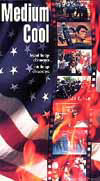 ctress to say 's--t' in a major motion picture).
ctress to say 's--t' in a major motion picture).
The bold and quirky British romantic comedy Georgy Girl (1966) set in swinging London (with a star-making role for Oscar-nominated Lynn Redgrave) was the first film in the US that carried a rating of M ("Suggested for Mature Audiences Only"). Brian De Palma's draft-dodger comedy Greetings (1968), (Robert DeNiro's debut film), was the first film in the US to receive an X rating by the MPAA for nudity and profanity (in its original release), although it was reduced to an R rating.
Cinematographer Haskell Wexler directed his feature debut film - the cinema-verite , non-exploitative adult film Medium Cool (1969), originally rated X due to full-frontal nudity and violence - about a television news cameraman covering the 1968 Chicago Democratic Convention. Another controversy erupted over the inter-racial love scene between guerrilla leader Raquel Welch and deputy Jim Brown in 100 Rifles (1969) - rated R.
Both Robert Aldrich's lesbian film The Killing of Sister George (1968), and first-time director Paul Mazursky's successful sex comedy about swinging and group therapy, Bob & Carol & Ted & Alice (1969), gave evidence that sexual permissiveness and a new liberalism about sexual mores had emerged in Hollywood. The title of the trashy melodramatic film Valley of the Dolls (1967), adapted from Jacqueline Susann's best-selling book and starring Barbara Perkins, Patty Duke, and Sharon Tate as three fame-seeking women, referred to 'uppers' and 'downers' - barbiturate pills.
The Best Picture Oscar in 1969 went to English director John Schlesinger's X-rated Midnight Cowboy (1969) with the Harry Nilsson theme song Everybody's Talking. This archetypal "New Hollywood" 70s film told the story of the close relationship between a naive Texan stud (Jon Voight) and a grizzled derelict (Dustin Hoffman), two men forced to live in "; ">1970 The New Decade for Film-Makers:
Although the 1970s opened with Hollywood experiencing a financial and artistic depression, the decade became a creative high point in the US film industry. Restrictions on language, adult content and sexuality, and violence had loosened up, and these elements became more widespread. The hippie movement, the civil rights movement, free love, the growth of rock and roll, changing gender roles and drug use certainly had an impact. And Hollywood was renewed and reborn with the earlier collapse of the studio system, and the works of many new and experimental film-makers (nicknamed "Movie Brats") during a Hollywood New Wave.
The counter-culture of the time had influenced Hollywood to be freer, to take more risks and to experiment with alternative, young film makers, as old Hollywood professionals and old-style moguls died out and a new generation of film makers arose. Many of the audiences and movie-makers of the late 60s had seen a glimpse of new possibilities, new story-telling techniques and more meaningful 'artistic' options, by the influences of various European "New Wave" movements (French and Italian) and the original works of other foreign-language film-makers, and by viewing these surprise hits in the previous decade:
-
Antonioni's Blow-Up (1966)
-
Penn's Bonnie and Clyde (1967)
-
Nichols' The Graduate (1967)
-
Lindsay Anderson's If... (1968, UK)
-
Romero's Night of the Living Dead (1968)
-
Kubrick's 2001: A Space Odyssey (1968)
-
Penn's Alice's Restaurant (1969)
-
Hopper's Easy Rider (1969)
-
Haskell Wexler's Medium Cool (1969)
-
Robert Downey Sr.'s Putney Swope (1969)
-
Peckinpah's The Wild Bunch (1969)
Young viewers and directors, who refused to compromise with mediocre film offerings, supported stretching the boundaries and conventional standards of film even more in this decade. Although the 50s and 60s were noted for wide-screen epics on CinemaScopic silver screens (and lighter formulaic, squeaky-clean fare such as Pillow Talk (1959) or Beach Blanket Bingo (1965)), the 70s decade was noted for films with creative and memorable subject matter that reflected the questioning spirit and truth of the times.
Motion picture art seemed to flourish at the same time that the defeat in the Vietnam War, the Kent State Massacre, the Watergate scandal, President Nixon's fall, the Munich Olympics shoot-out, increasing drug use, and a growing energy crisis showed tremendous disillusion, a questioning politicized spirit among the public and a lack of faith in institutions - a comment upon the lunacy of war and the dark side of the American Dream (documented, for instance, in the bicentennial year's All the President's Men (1976)). Other films that were backed by the studios reflected the tumultuous times, the discontent toward the government, lack of US credibility, and hints of conspiracy paranoia, such as in Alan J. Pakula's post-Watergate film The Parallax View (1974) with Warren Beatty as a muckraking investigator of a Senator's death. The Strawberry Statement (1970), derived from James S. Kunen's journal and best-selling account of the 1968 student strike at Columbia and exploited for its countercultural message by MGM, echoed support of student campus protests. Even Spielberg's Jaws (1975) could be interpreted as an allegory for the Watergate conspiracy.
1960s social activism often turned into an inward narcissism, and yet this uncertain age gave rise to some of the finest, boldest, and most commercially-successful films ever made, such as the instant Oscar-winning blockbuster The Godfather (1972) by a virtually untested director, William Friedkin's horror classic The Exorcist (1973), Spielberg's Jaws (1975) and Close Encounters of the Third Kind (1977), and Lucas' Star Wars (1977).
The decade also spawned equally memorable cult films, as diverse as Monte Hellman's Two-Lane Blacktop (1971) and the quirky Willy Wonka & The Chocolate Factory (1971). Jerry Schatzberg's and 20th Century Fox's raw, relentless and uncompromising The Panic in Needle Park (1971) (produced by Dominick Dunne) starkly portrayed heroin drug use among addicts in New York City, with Al Pacino in his first major acting role as a drug pusher and part of a heroin-doomed couple (opposite Kitty Winn). Czechoslovakian film-maker Milos Forman's first American film Taking Off (1971) insightfully satirized the adult middle-class and its supposed generation gap from the youth generation. There were also times when expected hits turned to disasters, however, such as the musical fantasy remake Lost Horizon (1973) and Martin Scorsese's darkly expressionistic period musical New York, New York (1977).
Science-Fiction Films of the 70s:
Besides the splashy, big-budget Spielberg-Lucas sci-films of the decade, there were other speculative, innovative, and thought-provoking examples in the genre:
-
a popular, clever, mostly successful and serious five-film series of classic simian films (spanning 1968 to 1973) about apes that have evolved into an intelligent society, derived from Pierre Boule's novel Monkey Planet, originating with Planet of the Apes (1968)
-
director Robert Wise's tense The Andromeda Strain (1971) adapted from Michael Crichton's best-selling novel about a strange bacterial agent
-
the sci-fi disaster film The Omega Man (1971) with Charlton Heston as the sole survivor of germ warfare unleashed on Earth, who struggled to survive in the city of LA over-run by mutant scavengers
-
special-effects genius Douglas Trumbull's directorial debut film - the speculative Silent Running (1972)
-
Richard Fleischer's dark futuristic Soylent Green (1973) in which Charlton Heston as an investigating cop revealed the source of people's food in the year 2022 in Manhattan
-
Michael Crichton's Westworld (1973) told about a holiday resort where androids malfunctioned (Yul Brynner starred as a deadly robotic gunslinger)
-
John Boorman's visually surreal Zardoz (1974) with Sean Connery
-
the satirical sci-fi thriller The Stepford Wives (1975) told of women who were replaced by perfect homemaker robots (who wore flowery dresses and cooked gourmet meals) in order to please their husbands
-
Norman Jewison's ultra-violent Rollerball (1975) with James Caan as brutal sports champion Jonathan E.
-
Michael Anderson's dystopic view of society in the year 2274, Logan's Run (1976), starring Michael York (as a Sandman) and Jenny Agutter who flee the city to Sanctuary (the ruins of Washington DC inhabited by Peter Ustinov) after learning about the after-30 euthanistic policies of their society
-
Peter Hyams' Capricorn One (1978) about a faked NASA Mars landing and mission (with OJ Simpson as one of the astronauts!)
-
Disney's dark sci-fi adventure film The Black Hole (1979), one of the studio's earliest PG films, was an attempt at challenging or duplicating Lucas' Star Wars, although it only succeeded with its dazzling special effects a
 nd John Barry score
nd John Barry score
-
a TV and Star Wars-inspired Star Trek - The Motion Picture (1979) - the first adaptation of the successful TV show, with Captain Kirk (William Shatner) now an Admiral, reunited with Spock (Leonard Nimoy) and "Bones" McCoy (DeForest Kelley) on the starship Enterprise
-
legendary director Stanley Donen's and John Barry's Saturn 3 (1980), a serious science-fiction film that was ignored and bombed at the box office, starring Kirk Douglas and Farrah Fawcett (at the height of her popularity from the TV series Charlie's Angels, and with a brief topless scene that brought the film most of its attention) located on a research space station near Saturn where they are developing hydroponics-grown food for a struggling Earth
1980 Trends of the 70s Extend Into the 80s: The Introduction of 'High-Concept' Films
The decade of the 1980s tended to consolidate the gains made in the seventies rather than to initiate any new trends equal to the large number of disaster movies, buddy movies, or "rogue cop" movies that characterized the previous decade. Designed and packaged for mass audience appeal, few 80s films became what could be called 'classics'.
The era was characterized by the introduction of 'high-concept' films - with cinematic plots that could be easily characterized by one or two sentences (25 words or less) - and therefore easily marketable and understandable. Producer Don Simpson (partnered with Jerry Bruckheimer) has been credited with the creation of the high-concept picture (or modern Hollywood blockbuster), although its roots could be seen in the late 70s (i.e., the prototypical Jaws (1975), Saturday Night Fever (1977), Star Wars (1977), Alien (1979) - known in high-concept terms as "Jaws in Space").
Simpson was the first producer to understand and exploit the significance of MTV. His action-packed, loud, flashy, simplistic, and tightly-structured films brought crowds to the multiplexes every summer. His lowest common-denominator films reflected the MTV generation, such as in his debut film Flashdance (1983) - with its pop soundtrack and iconic 'freeze-frame' ending. Other successes followed in the 80s: Beverly Hills Cop (1984) with its 'fish-out-of-water' high concept, the sexy Thief of Hearts (1984), the high-flying Top Gun (1986) - the epitome of Simpson's technique, and the stock-car racing film Days of Thunder (1990) again with Tom Cruise. By the end of the 80s era as a result, most films were not designed for 'thinking' adult audiences (such as Driving Miss Daisy (1989)), but were 'low-brow' for dumbed-down teen audiences looking for sheer entertainment value or thrills (for example, Bill & Ted's Excellent Adventure (1989), James Cameron's Aliens (1986), or Die Hard (1988)).
After the innovations of the 70s, films in the 80s were less experimental and original, but more formulaic, although there was a burst of films eager to capitalize on new special effects (CGI) techniques - now available. Predictions were grim for the industry - production costs were soaring while ticket prices were declining. The average ticket price at the beginning of the decade was about $3, and over $4 by the end of the decade, while the average film budget was over $18 million. However, fears of the demise of Hollywood proved to be premature.
Dance-Musical Films:
Although the much-publicized Annie (1982) by renowned director John Huston failed, other non-traditional dance musicals flourished:
-
Staying Alive (1983), written and directed by Sylvester Stallone, starred John Travolta (in his 10th film) as an aspiring Broadway dancer (six years after Saturday Night Fever (1977)); although successful at the box-office, it contributed to the downfall of Travolta's career for the rest of the decade
-
Adrian Lyne's slick Flashdance (1983) was the immensely popular, highly kinetic, music-video style film - with an Oscar-winning title song by Irene Cara. It featured 19 year-old Jennifer Beals in her first starring role as Alex - a day welder in Pittsburgh and night dancer in a men's club who aspired to successfully audition for ballet school. [The film almost singlehandedly inspired off-the-shoulder, oversized torn sweatshirts, legwarmers, the aerobics exercise class craze of the 80s, and the skillful art of removing one's bra from under one's shirt; it also introduced two newcomers, writer Joe Eszterhas and producer Jerry Bruckheimer (who went on to produce Beverly Hills Cop (1984) and Top Gun (1986), among other films)]
-
Footloose (1984) with John Lithgow as a strict minister and Kevin Bacon as the illegal dancer in town featured Kenny Loggins' hit single of the title song
-
Singer Prince (his first starring film) played "The Kid" in the feature-length m
 usic video Purple Rain (1984), and succeeded in having the #1 movie, album, and single simultaneously
usic video Purple Rain (1984), and succeeded in having the #1 movie, album, and single simultaneously -
the teen-oriented dance/romance Dirty Dancing (1987) about a young girl named Baby (Jennifer Grey, Joel's daughter) finding sexual awakening with Patrick Swayze in the early 60s through wild dancing at a Catskills vacation resort
-
Western-style Saturday Night Fever film, James Bridges' Urban Cowboy (1980) featured Houston honky-tonks, mechanical bull-riding in bars, blue-collar cowboys, and country music dancing (including the Cotton-Eyed Joe) - and popular young stars John Travolta and Debra Winger
1990 The Decade of Money, Mega-Spending and Special Effects:
In the 1990s for the most part, cinema attendance was up - mostly at multi-screen cineplex complexes throughout the country. Although the average film budget was almost $53 million by 1998, many films cost over $100 million to p roduce, and some of the most expensive blockbusters were even more. In the early 1990s, box-office revenues had dipped considerably, due in part to the American economic recession of 1991, but then picked up again by 1993 and continued to increase. The average ticket price for a film varied from about $4.25 at the start of the decade to around $5 by the close of the decade. As indoor multiplexes multiplied from almost 23,000 in 1990 to 35,600 in the year 2000, the number of drive-ins continued to decline (from 910 in 1990 to 667 in 2000).
roduce, and some of the most expensive blockbusters were even more. In the early 1990s, box-office revenues had dipped considerably, due in part to the American economic recession of 1991, but then picked up again by 1993 and continued to increase. The average ticket price for a film varied from about $4.25 at the start of the decade to around $5 by the close of the decade. As indoor multiplexes multiplied from almost 23,000 in 1990 to 35,600 in the year 2000, the number of drive-ins continued to decline (from 910 in 1990 to 667 in 2000).
There still existed an imbalanced emphasis on the opening weekend, with incessant reports of weekly box-office returns, and puffed-up reviews and critics' ratings. The belief was sustained that expensive, high-budget films with expensive special effects (including shoot 'em-ups, stereotypical chase scenes, and graphic orchestrated violence) meant quality. However, the independently-distributed film movement was also proving that it could compete (both commercially and critically) with Hollywood's costly output.
Pressures on conventional studio executives to make ends meet and deliver big hit movies increased during the decade. Higher costs for film/celebrity star salaries and agency fees, spiraling production costs, promotional campaigns, expensive price tags for new high-tech and digital special-effects and CGI (computer generated images), costly market research and testing (to develop risk-averse, formulaic, stale, and over-produced films), scripts created by committee, threats of actor and writer strikes, and big-budget marketing contributed to the inflated, excessive spending (for inferior products) in the Hollywood film industry. True character development, interesting characters, credible plots, and intelligent story-telling often suffered in the process.
The Digital Age and Home Viewing:
The VCR was still a popular appliance in most households (about three quarters of them in 1991) and rentals and purchase of videotapes were big business - much larger than sales of movie theater tickets. Rather than attending special film screenings, members of the Academy of Motion Pictures viewed Oscar-nominated films on videotape, beginning in 1994. The signs of the burgeoning of the digital age portended revolutionary change. In 1990, Kodak introduced the Photo CD player. And in 1992, the Second Edition of the 20-volume Oxford English Dictionary, was also made available on CD-ROM. By 1992, broadcast TV was beginning to lose large numbers of viewers to cable-only channels.
By 1997, the first DVDs (digital video discs) had emerged in stores, featuring sharper resolution pictures, better quality and durability than videotape, interactive extras, and more secure copy-protection. In just a few years, sales of DVD players and the shiny discs proliferated and would surpass the sale of VCRs and videotapes.
And with the digital revolution, some pioneering film-makers were experimenting with making digital-video (DV) films, pushing digital imagery and special effects, or projecting films digitally. A number of films also used special-effects CGI in more subtle, innovative ways:
-
Warren Beatty's Dick Tracy (1990) was the first 35 mm feature film with a digital soundtrack
-
Wolfgang Petersen's In the Line of Fire (1993) included retouched footage of political crowd scenes
-
Jurassic Park (1993) was the first film with DTS sound; other DTS films included Best Picture-winning Braveheart (1995), Best Sound-winning Apollo 13 (1995), Twister (1996), Independence Day (1996), the Star Wars Trilogy 1997 re-release, Batman and Robin (1997), and Con Air (1997)
-
Forrest Gump (1994) used digital photo trickery to insert a person into historical footage, to erase the legs of amputee Gary Sinese, and to enhance the ping-pong game
-
Heavenly Creatures (1994) enhanced its fantasy sequences (visions of the "4th World" called Borovnia - a "heaven without Christians" inhabited by clay people) with CGI
-
Lars von Trier, founder of the Dogme 95 movement, directed the distinctive Breaking the Waves (1996) and showed how digital-video (and its hand-held cinema verite look) could be viable for dramatic feature films
-
The English Patient (1996) was the first Oscar-winning American film with a digitally edited soundtrack - two of its nine awards were for Best Film Editing and Best Sound
-
George Lucas' Star Wars Episode I: The Phantom Menace (1999) included characters that were entirely digitally rendered, such as Jar Jar Binks
-
Established directors experimented with Denmark director Lars von Trier's Dogme 95 fresh and improvisational approach to film-making, with groundbreaking techniques using digital video, including: Spike Lee's Bamboozled (2000), Barbet Schroeder's Our Lady of the Assassins (2000), Mike Figgis' Timecode (2000) and Hotel (2001), Eric Rohmer's The Lady and the Duke (2001), Richard Linklater's Waking Life (2001), Rebecca Miller's Personal Velocity: Three Portraits (2001), Steven Soderbergh's Full Frontal (2002), and Gary Winick's Tadpole (2002)
-
Lucas' second Star Wars pre-quel: Attack of the Clones (2002) was the first major Hollywood motion picture to be filmed entirely with digital video (at 24 fps)
One of the emerging trends of the late 80s and 90s was that although about the same number of pictures were produced as in the "Golden Age of Hollywood" (about 450-500 in a year), many of the films that were produced (some estimates say 40%) went directly to video (laserdisc or DVD) or cable with no cinematic theatrical release at all. And the window of time between a film's theatrical
opening and availability for cable TV or home viewing shrunk. The proliferation of films helped to assuage the tremendous appetite for new products demanded by cable stations, video rental stores, the local megaplexes, digital satellite services, foreign markets, and the Internet. In the early 90s, the World Wide Web was born, and home computers were becoming the hot new technology - with vast repercussions for the film industry. [One of the decade's many films about malevolent computers was The Net (1995) with Sandra Bullock.]
2000 The First Decade of the New Millennium: Change and I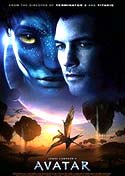 nnovation
nnovation
Although technically, the new millennium dawned on January 1st 2001, the new decade of films (and film history) began on January 1, 2000. It began with trumped fears over Y2K and major terrorists attacks on 9/11/2001, was marked at its midpoint with the devastating natural disasters of the Asian tsunami of 2004 and of Hurricane Katrina in 2005, and ended with the financial meltdown of the economy (the second crash and recession of the decade). The end of the decade was punctuated by James Cameron's revolutionary and major blockbuster film Avatar (2009), the highest grossing (domestic) film of 2009 - and of the decade. [It became only the fifth film in movie history to exceed $1 billion in worldwide grosses, and did so in less than 3 weeks.] The film soon surpassed the highest-grossing (worldwide) film of all-time - Cameron's own Titanic (1997).

The decade was overwhelmed by the ascendancy of Google, Amazon, YouTube, the blogosphere, Craigslist, new media and social networking sites (MySpace, Facebook, Twitter, etc), reality TV (capped by Survivor and American Idol), the popular game show Who Wants to Be a Millionaire, Netflix, and 24/7 cable news shows - all competing for audiences or market share. New tech products included ubiquitous laptops (smaller and smaller), the iPod, Skype, Hulu, eBooks, Blackberrys and smart phones. Television moved from analog to digital broadcasting - and new flat-screens replaced bulky cathode-ray tubes, video rental stores converted to DVDs, and dial-up connections became broadband. Answering machines, real Rolodexs, reservations by phone, heavy phonebooks and cellphones, lickable stamps, VHS tapes (and players) and insertable floppy disks all went by the wayside.
Although the first TiVo digital video recorder (DVR) shipped in early 1999, it wasn't until the decade of the 2000s, after further technological improvements, that it became a commonplace media appliance for recording TV programs - allowing for 'time-shifting' of viewing, and for fast-forwarding through commercials. However, the majority of DVRs now in use were being installed in cable or satellite set-top boxes, threatening to make stand-alone TiVo machines also obsolete. Sensationalized celebrity deaths were a new phenomenon -- surrounding the demise of Anna Nicole Smith, Michael Jackson, and Farrah Fawcett - among o thers.
thers.
Listing of Major Film Franchises in the 2000s:
T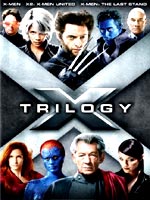 he era began with the following major franchises or series of films:
he era began with the following major franchises or series of films:
-
the complete X-Men series (2000-2006) - X-Men (2000), X2: X-Men United (2003), and X-Men: The Last Stand (2006) plus the origin film X-Men Origins: Wolverine (2009) - X-Men (2000) was the first major Marvel superhero comic ever adapted for the screen, and also one of the most profitable film franchises (of comics).
-
Peter Jackson's complex, monumental The Lord of the Rings trilogy epic (2001-2003) (based upon the writings and fantasy epics of J.R.R. Tolkein), regarding a Middle Earth world of wizards, elves, villains, hobbits, a CGI creature named Gollum (Andy Serkis), and a quest to destroy a ring: The Lord of the Rings: The Fellowship of the Ring (2001), The Lord of the Rings: The Two Towers (2002), and The Lord of the Rings: The Return of the King (2003)
-
all three Shrek films (2001-2007), DreamWorks' revisionist fairy tale with the loveable green, fat ogre Shrek (Mike Myers), a Prince Charming for Princess Fiona (Cameron Diaz): Shrek (2001), Shrek II (2004), and Shrek the Third (2007)
-
all six of the magical wizardry Harry Potter films (derived from the J.K. Rowling novels) to date (2001-2009), featuring the "Chosen One" Harry Potter (Daniel Radcliffe) and his student friends (Rupert Grint, Emma Watson) battling "He Who Must Not Be Named" Lord Voldemort (Ralph Fiennes) at Hogwarts School: Harry Potter and the Sorcerer's Stone (2001), Harry Potter and the Chamber of Secrets (2002), Harry Potter and the Prisoner of Azkaban (2004), Harry Potter and the Goblet of Fire (2005), Harry Potter and the Order of the Phoenix (2007), and Harry Potter and the Half-Blood Prince (2009)
-
four Fast and Furious actioners (2001-2009): The Fast and the Furious (2001), 2 Fast 2 Furious (2003), The Fast and the F
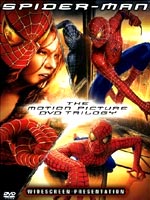 urious: Tokyo Drift (2006), and Fast & Furious (2009)
urious: Tokyo Drift (2006), and Fast & Furious (2009) -
the three-part Spider-Man films (2002-2007): Spider-Man (2002), Spider-Man 2 (2004), and Spider-Man 3 (2007)
-
the Bourne Trilogy (2002-2007) based upon Robert Ludlum spy novels: The Bourne Identity (2002), The Bourne Supremacy (2004), and The Bourne Ultimatum (2007)
-
three Pirates of the Caribbean films (2003-2007), a trilogy of supernatural pirate films with a legendary nemesis (Barbossa, Davy Jones), and a love triangle involving heroic Will Turner (Orlando Bloom), the beautiful spunky damsel Elizabeth Swann (Keira Knightley), and Johnny Depp as the swashbuckling, eccentric pirate scoundrel Captain Jack Sparrow: Pirates of the Caribbean: The Curse of the Black Pearl (2003), Pirates of the Caribbean: Dead Man's Chest (2006), and Pirates of the Caribbean: At World's End (2007)
Pixar's Ascendancy as Feature-Film Animator:
In early 2006, the Walt Disney Co. bought longtime partner Pixar Animation Studios Inc. for $7.4 billion in stock, after a twelve year relationship in which Disney co-financed and distributed Pixar's animated films and split the profits. Of the ten, highly-acclaimed and award-winning CGI films released by Pixar since 1995, seven were released in the decade (averaging almost one each year), and the second sequel Toy Story 3 (2010) debuted in 2010:
-
F
 inding Nemo (2003) - This wildly-successful, breakthrough animation was the highest-grossing G-rated computer-animated film ever, Pixar's and Disney's fifth collaboration. It won the Oscar for Best Animated Feature Film! The undisputed box-office champ of the year, it was a sentimental father-son search story. It told the tale of Marlin - a widowed clownfish's (voice by Albert Brooks) search in the Pacific Ocean, with a dopey and forgetful blue tang fish named Dory (voice by Ellen DeGeneres), for missing son Nemo with a withered fin.
inding Nemo (2003) - This wildly-successful, breakthrough animation was the highest-grossing G-rated computer-animated film ever, Pixar's and Disney's fifth collaboration. It won the Oscar for Best Animated Feature Film! The undisputed box-office champ of the year, it was a sentimental father-son search story. It told the tale of Marlin - a widowed clownfish's (voice by Albert Brooks) search in the Pacific Ocean, with a dopey and forgetful blue tang fish named Dory (voice by Ellen DeGeneres), for missing son Nemo with a withered fin. -
The Incredibles (2004) - director/screenwriter Brad Bird's ingenious action-adventure animation won the Best Animated Feature Oscar. It was Disney's and Pixar's sixth collaboration, and Pixar's first PG-rated film and the longest CG animated film to date (at 115 minutes). It was the first computer-generated animation to successfully show believable human figures or characters, instead of the traditional animal, toy, and creature characters of previous animations. It told the tale of paunchy Bob "Mr. Incredible" Parr (voice of Craig T. Nelson), an ex-do-good Superhero suffering a mid-life crisis and living under-cover in suburbia, with his restless wife Helen (voice of Holly Hunter) - former rubber-limbed masked vigilante Elastigirl. Their children included long-haired daughter Violet (voice of Sarah Vowell) - capable of being invisible, son Dash (voice of Spencer Fox) - who could travel at supersonic speed, and baby Jack-Jack. The entire family was lured back into super-herodom against the evil Syndrome (voice of Jason Lee).
-
Cars (2006) - the seventh collaboration, an adventure comedy directed by John Lasseter told an anthropomorphic story about a stock-car (Lightning McQueen, voice of Owen Wilson) on a journey to the races - including nostalgia for Route 66 in a forgotten town called Radiator Springs.
-
Ratatouille (2007) - the eighth Pixar film - the first film after the Disney purchase - was by writer/co-director Brad Bird. It was a fable about a rat named Rémy (voice of Patton Oswalt) who lived in a Paris bistro-restaurant and had aspirations to be a chef. It also won the Oscar for Best Animated Feature Film.
-
W
 ALL-E (2008) - this was the ninth Pixar film and another Best Animated Feature Film Oscar winner - a profound animation and environmental cautionary tale (and silent-era throwback) about a waste-removal robot named WALL•E (meaning Waste Allocation Load Lifter Earth-Class) who in the year 2700 discovered the key to planet Earth's future after it was vacated and he was the last robot on Earth doing cleanup. When WALL•E met up with a cold-hearted female search robot named EVE from a space probe and fell robotically in love with her, he chased her across outer space. WALL-E's six nominations tied it with Beauty and the Beast (1991) as the most-nominated animated film.
ALL-E (2008) - this was the ninth Pixar film and another Best Animated Feature Film Oscar winner - a profound animation and environmental cautionary tale (and silent-era throwback) about a waste-removal robot named WALL•E (meaning Waste Allocation Load Lifter Earth-Class) who in the year 2700 discovered the key to planet Earth's future after it was vacated and he was the last robot on Earth doing cleanup. When WALL•E met up with a cold-hearted female search robot named EVE from a space probe and fell robotically in love with her, he chased her across outer space. WALL-E's six nominations tied it with Beauty and the Beast (1991) as the most-nominated animated film. -
Up (2009) - the 10th Pixar film (and another Best Animated Feature Film Oscar winner), an imaginative, life-affirming, coming-of-old-age tale and modern-day adventure classic about a 70s year-old hero - grouchy, elderly widower and balloon salesman Carl Fredricksen (voice of Ed Asner), who soared up in his helium-balloon lifted wooden home, and experienced a slow-building camaraderie with chubby 8 year-old stowaway Wilderness Explorer Scout Russell (voice of Jordan Nagai) as they sailed together to the jungles of South America (and Paradise Falls). It was the second animated film ever nominated for Best Picture (following Beauty and the Beast (1991)), won two Oscar awards: Best Animated Feature Film and Best Original Score, and was one of the top moneymakers of the year (at $293 million to date). It was the first CG-animated Best Picture nominee, and the first to receive a Best Picture nomination since animated films received their own category in 2001. It was the third consecutive Oscar in this category for Disney/Pixar, following Ratatouille (2007) and Wall-E (2008), with the studios now winning 5/9 awards since the new category was established in 2001.
Conclusion.
And so we have seen and have learned about a filmland a lot of new and have understood that its history begins for a long time and proceeds till now. The cinema constantly develops, and we see this way from the beginning when the first chamber shooting black-and-white silent film, till today, where cinema has been created represents the highest achievements in sciences thanks to the newest format 3-D and to improbable special effects.


